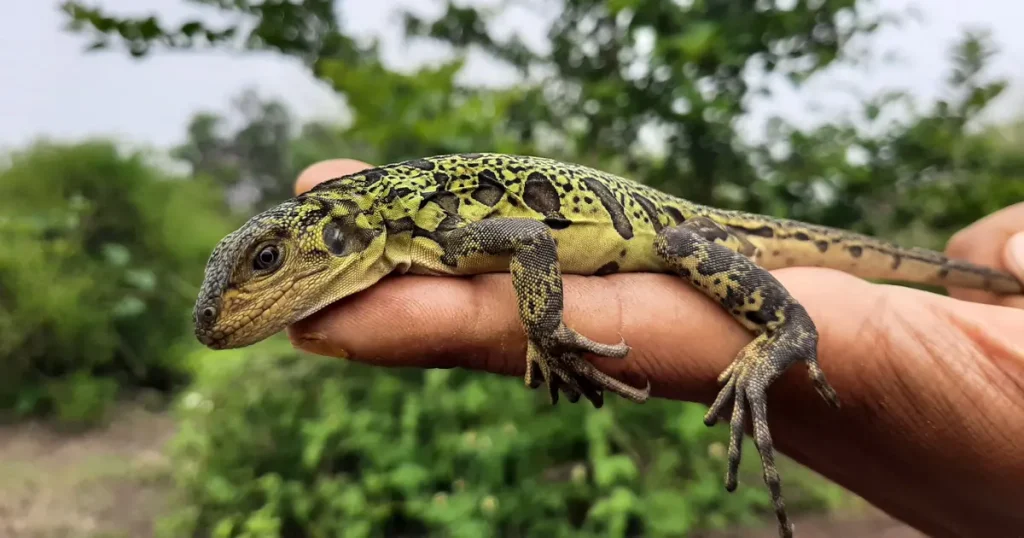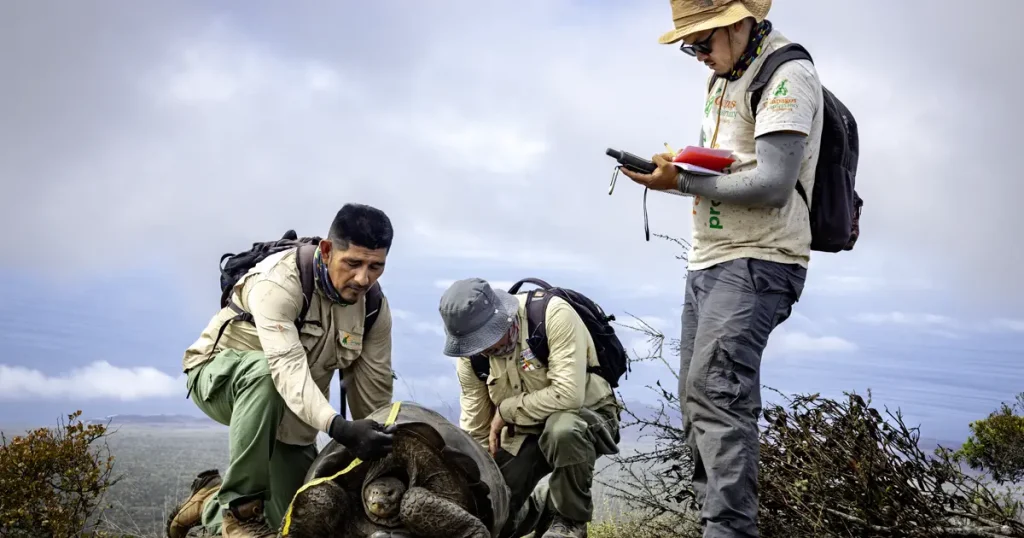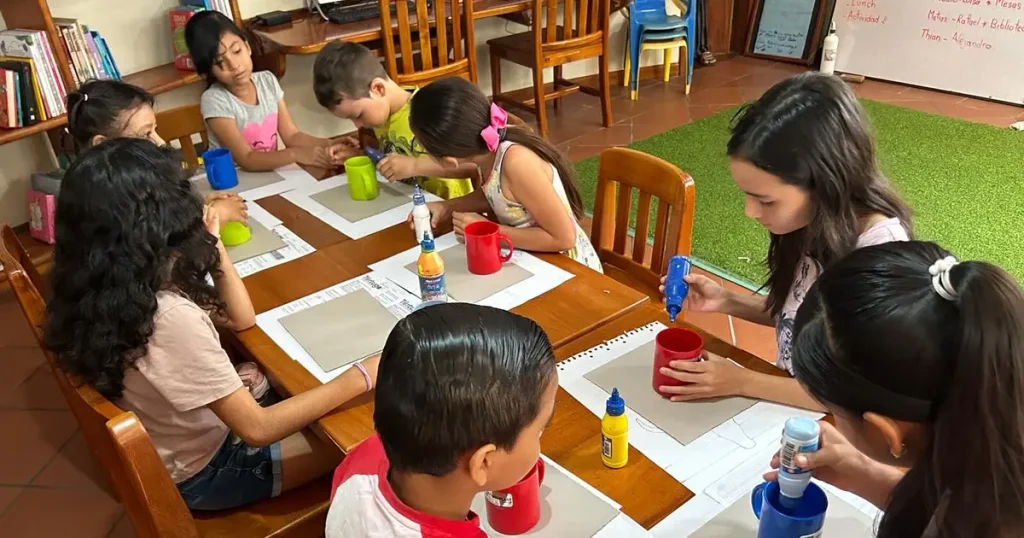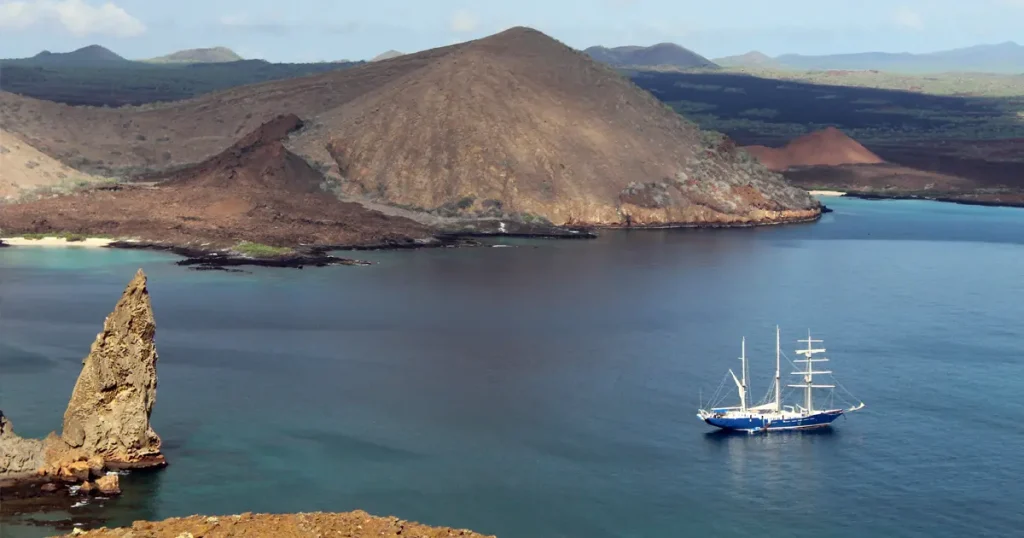Giant Tortoise Restoration in the Galápagos Islands
Iniciativa Galápagos (formerly known as the Giant Tortoise Restoration Initiative) is a collaborative effort led by Galápagos Conservancy and the Galápagos National Park Directorate (GNPD). The long-term goal of the initiative is to restore tortoise populations to their historical distribution and numbers across Galápagos, including on islands where tortoises went extinct. This historic effort is composed of four main components:
- Research and conservation on tortoises, vegetation, etc., on targeted islands
- Breeding and rearing tortoises of threatened species
- Repopulation of islands where tortoises went extinct
- Research and management of tortoise-human interactions and conflicts.
This ambitious initiative builds on a half century of tortoise research and conservation carried out by the Charles Darwin Research Station, the GNPD, and numerous visiting scientists and volunteers. Since its establishment in 1985, Galápagos Conservancy has supported much of this work.
Program Need
Giant tortoise species, along with the endemic rice rats, were the most historically decimated species in the Galápagos Islands. Humans, primarily buccaneers and whalers, exploited them as a food source during the 18th and 19th centuries. They were later harvested for oil. Today, limited poaching of tortoises still occurs in some areas. Introduced species (primarily rats, pigs, dogs, and the Solenopsis ant) prey on tortoises (particularly eggs and hatchling tortoises); others (goats, cattle, donkeys, and invasive plants) damage or destroy tortoise habitat.
A total of 15 tortoise species have been identified. According to the IUCN Red List, six are considered Critically Endangered, three Endangered, three Vulnerable, and two Extinct. In the case of the Fernandina tortoise, it is probably extinct but anecdotal information suggests that a few individuals may remain. The fifteenth species, from Santa Fe Island, went extinct in the mid-1800s; as there is no complete museum specimen, only pieces, the species was never officially described or named.
Tortoise Breeding and Rearing Programs: A Vital Tool for Restoring Populations
Rearing young tortoises in captivity to approximately 5 years of age prior to releasing them into the wild is a vital tool in rebuilding population numbers quickly. Tortoise mortality in the wild is highest over the first couple of years, often due to lack of food or water as well as tortoise hatchlings being easy prey for both endemic and invasive predators. Once a tortoise reaches five years old, it is more likely to survive to maturity. Captive rearing has been used in Galápagos since 1965 to help restore threatened tortoise populations of 9 of the 11 surviving species. Improvements in nesting areas and incubation and rearing techniques over the decades has made this one of the most successful conservation programs in Galapagos.
Milestones
- As of the end of 2017, more than 7,000 juvenile tortoises had been returned to their island of origin – including Española, Isabela, Pinzón, San Cristóbal, Santa Cruz, and Santiago.
- The first of nearly 2,000 juvenile tortoises returned to Española Island reached sexual maturity and have been reproducing naturally on the island since the early 1990s.
- In May 2010, 39 hybrid adult tortoises were sterilized and then released onto Pinta Island to act as ecosystem engineers during the vegetation recovery period following goat eradication.
Tortoise Centers
There are two Tortoise Centers in Galápagos, all managed by the Galápagos National Park Directorate with the support of Galápagos Conservancy. The Tortoise Center on Santa Cruz was originally established by the Charles Darwin Research Station (CDRS) in 1965, then run jointly with the GNPD, which assumed all management responsibilities in 1998. Since 2014, with the launch of the Giant Tortoise Restoration Initiative, Galápagos Conservancy scientists have served as advisors to ensure continued long-term success of all tortoise centers.
Santa Cruz Tortoise Center
- The Fausto Llerena Tortoise Center on Santa Cruz was started in 1965 to save the tortoise population on Pinzón Island. At the time, the Pinzón tortoise population consisted of fewer than 200 old adults and no juveniles. Throughout the 20th century, all hatchlings had apparently been killed by black rats, which were accidentally introduced to the island in the late 1800s. Without help, this population would eventually disappear.
- On Española Island, only 14 tortoises remained (2 males and 12 females). These were brought into captivity and a tortoise breeding program began. A third Española male was returned to Galapagos in 1976 from the San Diego Zoo.
- In addition to Pinzón and Española, juvenile tortoises reared in captivity for eventual release back into the wild come from Santa Cruz and Santiago Islands. Tortoise eggs and/or hatchlings are collected from natural nests of these Critically Endangered species and brought to the Center.
- Since 2015, the juvenile Española tortoises born in captivity have been released onto Santa Fe to contribute to the island’s ecological restoration.
- A breeding program to restore tortoises to Floreana Island, where the native tortoise species went extinct in the 1800s, began in 2017.
Isabela Tortoise Center
- The Arnaldo Tupiza Tortoise Center on Isabela Island was inaugurated in 1995, in response to a major fire on southern Isabela that was threatening tortoise habitat and to help rebuild the various subpopulations more rapidly.
- The Center includes breeding groups of tortoises from Cerro Azul (Endangered) and Sierra Negra (Critically Endangered), which produce young for eventual return to the wild.
- The Center houses 69 breeding adults and produces approximately 250 young per year
Restoring Existing Tortoise Populations

The long-term goal of the Giant Tortoise Restoration Initiative is to restore all tortoise populations to their historical distribution and numbers. When the Galapagos National Park was established in 1959, there were 11 surviving tortoise species. Some were on a path to extinction. Others, while vulnerable or threatened, could survive without human intervention.
Given that the historical population throughout the Archipelago was between 200,000-300,000 tortoises, and the current population is 10-15% of that, this recovery will be a long, slow process. The primary method to rebuild these populations as quickly as possible is by collecting eggs and/or hatchlings from natural nests and rearing the young in captivity, by-passing the years of highest mortality before releasing them back into the wild.
Milestones
- In early 2020, the decision was made by the Environmental Ministry of Ecuador to end the captive breeding program for Española tortoises due to not only the success of the 40-year-old program, but of GTRI efforts to restore the habitat of the island to make it suitable for tortoises.
- As of the end of 2017, more than 7,000 juvenile tortoises returned to their island of origin – including Española, Isabela, Pinzón, San Cristóbal, Santa Cruz, and Santiago.
- The first tortoises repatriated to Española Island reached sexual maturity and began nesting in the early 1990s. The population has been increasing naturally on the island since that time.
- Black rats, introduced to Pinzón Island in the late 1800s, were eradicated in 2012. Natural recruitment of juvenile tortoises into the wild population has since begun.
- The first-ever complete census of the San Cristóbal tortoise population, completed in November 2016, resulted in a population estimate of 6,700 animals, with many juveniles and subadults (tortoises less than 20-25 years old).
- The Eastern Santa Cruz Tortoise was determined to be a separate species from the larger tortoise population on the western side of Santa Cruz. The publication officially naming the new species Chelonoidis donfausti came out in 2015.
- Goats and donkeys were eliminated from northern Isabela and Santiago Islands in 2006; pigs were also eliminated from Santiago (they were not present on northern Isabela).
- Goats were eliminated from Pinta Island in 2006.
Española (Chelonoidis hoodensis). The Española tortoise population was the closest to extinction in 1959. Through a 50-year breeding program, the population is healthy and recovering. However, the result of decades of goats on the island (eradicated in 1978) and the absence of significant numbers of tortoises resulted in changes to the vegetation that negatively impact the recovery of the tortoise population – primarily the vast thickets of woody vegetation that prohibit movement of the tortoises. GTRI personnel have been studying the inter-relationships among tortoises, cactus and woody vegetation to determine the best strategy for improving tortoise habitat so that the population can continue to expand in both distribution and number.
Pinzón (C. duncanensis). The Pinzón tortoise population was also on the road to extinction due to 100% predation of tortoise eggs/hatchlings by introduced black rats beginning in the late 19th century. Repatriations began in 1970, and the population is doing well. In December 2012, the Galapagos National Park Directorate led a successful campaign to eradicate the introduced black rats. In 2014, tortoise hatchlings were observed on the island for the first time in a century. Rearing young tortoises in captivity will continue to help the population increase more rapidly.
San Cristóbal (C. chathamensis). When the GTRI was launched, the San Cristóbal tortoise population was one of the least well-known. A breeding center was established there in 2004 to build up the population, but it was not known at the time whether that was a necessary tool for that population. An island-wide census was finally carried out by the GTRI team in November 2016. Nearly 2,000 tortoises were marked, and the population was estimated at 6,700. The high number of juveniles and sub-adults indicated a healthy, growing population. Future work on San Cristóbal will focus on the expanding range of the tortoises into the farmlands of the western half of the island.
Santa Cruz – Western (C. porteri) and Eastern (C. donfaustoi). Until recently, the giant tortoises of Santa Cruz Island were considered a single species. In 2015, the Eastern Santa Cruz Tortoise was designated a separate species. Both species are Critically Endangered. The western species has a large population but is still much smaller than the historical population. It is threatened by feral pigs, which dig up tortoise nests and eat the eggs and/or hatchlings), and human-tortoise conflicts. The eastern species is endangered in part because of its small population. Knowledge of this species is limited. The introduced Solenopsis ant, which attacks tortoise hatchlings in nests and as they emerge, is present in nesting zones of both species. A complete census is planned of the eastern species to determine number, range, threats, and health of the population. To increase population numbers more rapidly, eggs and/or hatchlings are collected from natural nests and reared in the Tortoise Center, to be released at 4-5 years old.
Santiago (C. darwini). The Santiago tortoise is also Critically Endangered, in large part due to exploitation in past centuries. Due to the ease of removing female tortoises (closer to the coast and lighter), exploitation by whalers and other mariners skewed this population to mostly males, which is a severe limit to population growth. To rebuild the population more quickly, eggs and/or hatchlings are collected from natural nests and reared in the Tortoise Center and then released at 4-5 years old. A more recent threat is the expansion of the introduced blackberry following the eradication of pigs, donkeys, and goats. These thickets are impenetrable, hindering tortoise use of the habitat and potentially blocking migrations. Further study and habitat management is needed.
Southern Isabela – Cerro Azul Volcano (C. vicina) and Sierra Negra Volcano (C. guntheri). The Sierra Negra tortoise population was historically the largest in the Archipelago, estimated at over 70,000 animals. Fewer than 1,000 remain. The historical Cerro Azul population was estimated at 18,000 animals, with fewer than 3,000 remaining. These volcanoes both have numerous subpopulations of tortoises that do not appear to intermix in current times. Poaching, while not a problem for most Galapagos giant tortoise species, is ongoing, albeit at a limited level, on southern Isabela. Both species have breeding groups at the Tortoise Center in Puerto Villamil. Offspring are released on a regular basis. Much more research is needed to determine the complex genetics of these two species and to provide better population estimates. Work is also needed to reduce and eventually eliminate poaching.
Northern Isabela – Alcedo Volcano (C. vandenburghi), Darwin Volcano (C. microphyes) and Wolf Volcano (C. becki). The three tortoise species on the northern volcanoes of Isabela are generally healthier populations than most of the other species. The tortoises on Alcedo and Wolf are considered Vulnerable, while those on Darwin are designated as Threatened, due to its small population size as well as a lack of knowledge of this species. The population on Wolf Volcano has an odd mixture of tortoises from several of the other islands, mixed in with the native population. These are the result of humans moving tortoises during the time of the whalers. Some of the tortoises have interbred, producing offspring with partial ancestry from different islands. This occurrence has provided a treasure trove of tortoises that can be used to repopulate islands where tortoises are extinct. A breeding program to restore tortoises to Floreana Island was initiated in 2017 using tortoises collected from Wolf Volcano.
Fernandina (C. phantasticus). The status of the Fernandina Island tortoise is unknown. A single tortoise, the only known Fernandina tortoise in the world, was collected during the California Academy of Sciences expedition in April 1906. While thought to be extinct due to volcanic eruptions in past centuries, there have been anecdotal observations indicating that there may indeed still be a very few left on the island. A search will be conducted using both helicopter and ground crews to make a final determination.
Repopulating Islands Where Tortoises Went Extinct
One of the goals of the Giant Tortoise Restoration Initiative is to re-establish reproductive tortoise populations on islands where humans caused their extinction. Tortoises went extinct on Floreana and Santa Fe Islands in the mid-1800s and on Pinta Island in 2012, with the death of Lonesome George.

Over the last two decades, genetic analysis of Galapagos tortoises — both from the wild and from museum specimens — has opened a window of opportunity for cutting-edge conservation to restore tortoise populations to islands where they are extinct. This is an important component of island restoration, as these growing tortoise populations will provide ecosystem “engineering” by trampling vegetation, opening areas, and dispersing seeds, which helps to recover ecosystem processes and provides improved habitat conditions for other native species.
Milestones
- In May 2010, 39 hybrid adult tortoises were sterilized and then released onto Pinta Island to act as ecosystem engineers during the vegetation recovery period following goat eradication.
- In 2015-2017, the first 400 juvenile Española tortoises were released onto Santa Fe Island; additional releases will continue for the next 5-10 years.
- In November 2015, 32 adult tortoises were transferred from Wolf Volcano to the Fausto Llerena Tortoise Center on Santa Cruz; 19 of these were identified through genetic analysis to have partial Floreana tortoise ancestry.
- In March 2017, a breeding program aimed at restoring tortoises to Floreana was launched, with twenty tortoises with partial Floreana ancestry.
Santa Fe
The repopulation of Santa Fe Island with giant tortoises began in 2015. The Santa Fe tortoise species went extinct before any complete specimens were collected — thus an official description and scientific name do not exist. Genetic analysis has confirmed, using museum specimens of pieces of tortoises collected on Santa Fe, that this was a separate species, and has identified the Española tortoise as the species most closely related to the extinct Santa Fe species.
Tortoise repatriations to Española Island were suspended in 2013 while habitat studies and potential management are completed. A decision was then made to release the young Española tortoises produced in the Santa Cruz Tortoise Center onto Santa Fe, given their genetic similarity to the original Santa Fe tortoise. The first group of 201 juvenile tortoises ranging in age from 5-8 years old was released in the interior of the island in June 2015. Additional cohorts of juvenile tortoises are released annually. Follow-up surveys of these tortoises show near 100% survival and continued dispersal of individuals throughout a larger area. Ongoing research will focus on potential competition with the Santa Fe land iguana and the mid- to long-term impacts of the tortoises on the vegetation.
Floreana
The tortoises of Floreana went extinct a decade or two after Charles Darwin’s visit in 1835, with the last individuals most likely harvested for food. Geneticists from Yale University have identified hybrid tortoises on Wolf Volcano (on northern Isabela Island) with partial Floreana tortoise ancestry. Apparently, whalers abandoned a mixture of Galapagos tortoises there in centuries past. In November 2015, 19 tortoises with partial Floreana ancestry were transferred from Wolf Volcano to the Tortoise Center on Santa Cruz. An additional four tortoises already in the Center were also identified as having partial Floreana tortoise ancestry. A breeding program, initiated with 20 of these tortoises in 2017, will provide young tortoises to be released onto Floreana in the future. With a healthy tortoise population, genetically similar to the original species, the island will undergo a broader ecological restoration engineered by the released tortoises.
The restoration of the tortoise population is part of the larger Floreana Restoration Project, which will include the eradication of the introduced rodents and cats as a necessary step prior to the first release of tortoises into the wild, and the return of other species no longer present on the island (e.g., mockingbirds and snakes).
Pinta
Tortoises were thought to be extinct on Pinta Island for most of the first half of the 20th century. Then Lonesome George was sighted in 1971 and transported to the Santa Cruz Tortoise Center in 1972. Since then there have been extensive searches both on Pinta and in the world’s zoos for another Pinta tortoise. None was ever found. When Lonesome George died in June 2012, the species was officially extinct. As with the Floreana tortoise, a few tortoises have been found on Wolf Volcano with partial Pinta ancestry. Unfortunately, the number is not sufficient for initiating a breeding program. Additional searches, however, may discover more, or it may be that a replacement species, genetically similar to the Pinta tortoise, will be used.
Goats, introduced on Pinta in 1959, destroyed the vegetation. Their eradication in 2006 was the first step in restoring the Pinta ecosystem. Giant tortoises, the “engineers” of Galapagos terrestrial ecosystems, were considered a vital component of the ongoing process of ecosystem restoration. To provide a “bridge” until a decision is made as to which tortoises should be used to start a reproductive and self-sustaining population on the island, 39 adult tortoises with mixed ancestry from islands with healthy tortoise populations were sterilized and released onto Pinta in May 2010. These tortoises were monitored for two years. They expanded their range and are impacting the vegetation and maintaining open trails. This will help ensure a successful re-establishment of a reproductive tortoise population on Pinta in the future.



